THE GENERIC CONFEDERATE
John Hopper, 18th Missouri Infantry, SoSkAn
Introduction
Whilst the argument rages here about whether there should be more jeancloth in the ranks it is interesting to note that we are following in the footsteps of the self same discussion that has gone on in the US for more than ten years.
In order to bring about a greater uniformity, and accuracy in the Confederate ranks, there has been a great amount of research on the various materials, and styles. Much of this research has also taken into account the Confederate Depot system. However. this research has also been used to give rise to the generic look. The idea of which is to blend all the different impressions, Army of Northern Virginia, Army of Tennessee, 1863, 1864, into one mass of greater uniformly. This gives greater conformity to re-enacting units. I hope to show here that, whilst in many ways this is not all bad. It gives the public a better impression. it is never the less still quite inauthentic. It is not something one would have seen in real life.
It is also interesting to note that while in the US there is a tendency to avoid portraying any identifiable unit, in this country there are units that do depict specific units, 9th Kentucky Infantry, 55th Virginia Infantry, and the 1st Arkansas Infantry for example. This is at odds with the any notion of uniformity and standardisation in the ranks, as applied to American reenactment units, as all of the three examples above would have had totally different points and types of supply.
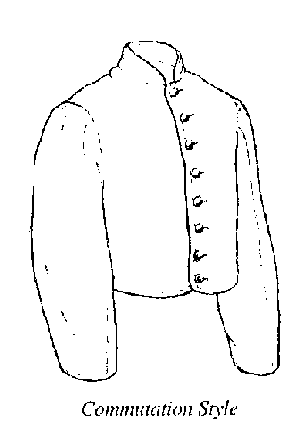
So, how easy is it to portray a Confederate unit, given that on one hand you have the romantic ragged rebel or the less romantic tramp with a gun theory, depending on your outlook. whilst on the other you have the blend in, lets all wear jeancloth, generic depot system?"
Well the answer is not that easy at all. One of the hardest impressions to do must surely be a Confederate Infantryman. Why is that?
At the start of the war, most of the uniforms were supplied under what was called the Commutation System (April 1861 - December 1861 / January 1862). These were uniforms procured either locally or nationally, with the Confederate Government agreeing to reimburse the cost. Many uniforms were issued by State authorities, some were from units that had been militia prior to the outbreak of hostilities. A few were made to curious designs, photos testify to this. A great many were made by local families for their sons, brothers, and husbands. There was some attempt at uniformity at a local level, but this only went as far as either the Regiment, the Company or perhaps even the Squad. There are cases of soldiers requesting items from home, as these first issue, or procured pieces, became useless. These tended to be items of need that were not met, usually socks, drawers etc. Some did ask for practical clothing, more what they were used to in every day life, as the early impracticable stuff was foreign to the men, and much of it made using a shoddy material, which fell apart quickly.
The first depot jackets appeared around late 1861, spring of 1862. What was called the second depot jackets appeared from spring 1862 to mid 1864, whilst the third and final depot jacket was issued from early 1864 onwards to the end of the war. It is, therefore, very apparent that there is considerable overlap in these time periods. It must be evident that at any one time several types, styles of jackets must have been used in units.
There is a marked difference between jackets made by different depots, at different times. Whilst the public may not (it is not always useful to presume this as fact, as he also may) know the variations, styles, materials, colours etc. used at those depots. Someone with an interest would find it very easy to spot the difference between what a Confederate in an 1863 Army of Tennessee unit would be wearing as opposed to a soldier in a 1863 Army Northern Virginia. Put simply, the units mentioned above, (most large clubs agree that the time frame is July 1863), should be quite distinguishable from each other by their cut and depot type, and should be of a particular type to fit the geographic location.
The units portrayed above served in different Armies, the 9th Kentucky and the 1st Arkansas in the Army of Tennessee, the 55th Virginia in the Army of Northern Virginia and would not have ever had the opportunity of serving together, let alone drawing from the same depot. It is true that the only time that Army of Northern Virginia troops ever had the chance of mixing with Army of Tennessee troops would have been during September 1863. Incidentally, this may be a better fine frame for clubs to act out.
Army of Tennessee
What uniforms would typically depict an Army of Tennessee soldier throughout the war?
Up until the spring of 1862, Army of Tennessee soldiers would, like their eastern cousins, have made a motley appearance. The chances of any unit looking like its fellow, or perhaps the chance of each company looking the same, would have been highly unlikely. At this point, the commutation system would have been in force, and what ever was considered martial would have been attractive to soldiers and officers commanding units. The raising of look-alike European units was all the rage. Every effort would have been attempted to get an overall look, but, as photographs show, this was not universally successful.
By the middle of summer, the first of the Georgia depot material would have made it's appearance. By far the most common jacket in the Army of Tennessee was the Columbus Depot. A jacket constructed of grey jeancloth with blue kersey or flannel trim on the collar and cuffs. It was made in two variations. The first had a five or six button front, two interior pockets, with an osnaburg lining. The second had a six or seven button front, one interior pocket, and one exterior pocket on the left breast. To give size of the operation at Columbus Depot, 263,922 jackets were produced from the middle of 1862, until the 20th May 1864. Production did not cease until April 1865. Other depots also produced jackets of the Columbus style.
One of those producing this jacket was Atlanta. In early 1864 the depot produced it's own pattern, a poor quality salt and pepper, or grey jeancloth with a unique style of it's own. It had the front panel cut so that right covers the left. It also had a six-button front, and was issued with wooden buttons. Troops may have put more martial style ones on their place. A variation on this had a single belt loop on the left. Production at Atlanta was huge. It produced 130.000 of these jackets alone in 1863.
Athens depot was setup after the Kentucky campaign of 1862. It produced jackets made from material captured there. The first pattern may have been similar to the Columbus style. It had produced 10,000 by July 1863.
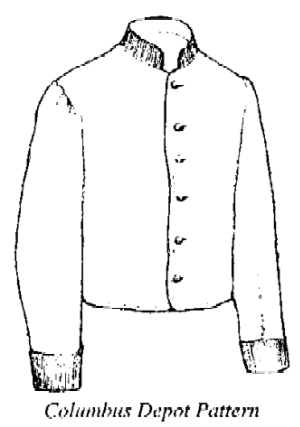
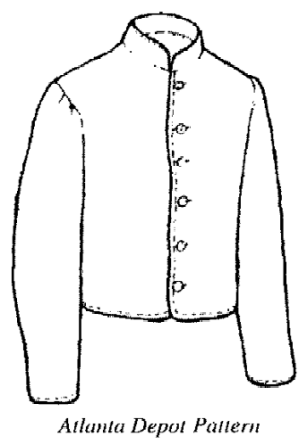
The Department of Alabama produced a jacket similar to the Columbus Depot one, possibly in either Columbus, Mississippi, or in Demopolis, Alabama. Although the style was reminiscent of the Columbus Depot, it had a five-button jacket with an exterior pocket, which was produced on left of right, but, had only collar trim of dark blue jeancloth. There was also a belt loop variation in existence. Another Alabama jacket, this time called the Alabama Depot was produced, possibly in Mobile or Montgomery, again with six or seven button front, a distinctive collar, and an exterior pocket. This type had a slant pocket on the left breast.
North Carolina was a widely used jacket. As North Carolina troops saw action on both the eastern and western fronts. it is perhaps one of the only ones that may have been universally issued to both Armies. The jackets used by the Army of Tennessee were of jeancloth, with again the standard osnaburg lining, with a six-button front. It was similar to the Columbus, but slightly shorter in the body. The Army of Tennessee had these issued at Dalton, Georgia, in the winter of 1863/64, and again at Palmetto, Georgia, in September 1864.

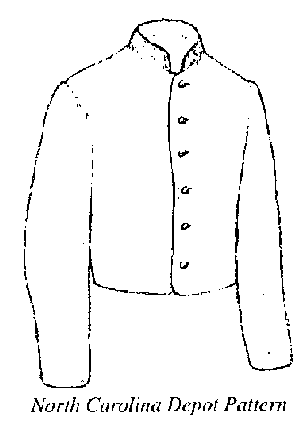
One further jacket that may have crossed the divide between the two armies was the Peter Tait jacket. Issued in very small quantities in late 1864, in particular around the blockade ports, it was purportedly issued to both armies. A cadet grey kersey, eight button front jacket, completely machine made, except for the buttonholes, with a linen lining.
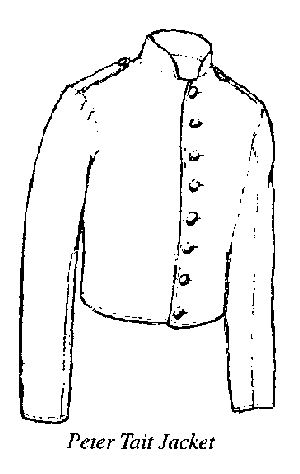
Conclusion then on an Army of Tennessee 1863 impression
The majority of any unit should, with out a shadow of a doubt be clothed in a jeancloth, Columbus Depot style jacket. Variations on this, say, of the Alabama or North Carolina, style (different external pockets, number of buttons etc.) may be added. With any unit, other than a Kentucky one, there may have been a smattering of the earlier style jackets. This would be men that had been in hospital, home on sick furlough, absent, in a desk job and perhaps missed an issue. Some could be wool, some could be home made with homespun jeancloth. It is about giving a rounded out appearance, not all the same, but not all different.
Arthur Freemantle mentions, in his description of Arkansas troops in the Army of Tennessee, "that the men were well clothed, without any attempt to uniformity in colour or cut, but nearly all were dressed in grey or brown coats and felt hats ". To give some idea to the size of the depot operation in the west, the Army of Tennessee received during the last six months of 1864, the following, 45,412 jackets, 102,864 pants, 102,558 shoes, plus 7,000 captured by Forrest. 27.900 blankets, 45,853 hats and caps, 61,860 cotton shirts, 108,937 drawers, and 55,560 pairs of socks.
There appears to have been no effort made by the western depot system, as far as I know, to produce an artillery man's jacket. It would appear that standard Columbus infantry jackets complete with blue trim, was issued to artillery. Some surviving ones have red sewn on at a later date, but not at the factory stage.
A Kentucky unit, (they were not called the Orphan Brigade for no reason), would have had to rely purely on the depot system. They would not have had the opportunity of getting things from home, and I would guess that if men did furlough home, they might not have been seen again. It is possible that a very small amount of earlier stuff may have been around, but not a lot.
Some of the clothing that one would not have seen in 1863. None of the men would have been issued with Atlanta style jackets, nor would any of the men have had any Richmond depot material. It is also arguable whether any Peter Tait style jackets (i.e. of a dark grey colour) should be in evidence. There are, what some historians have called, Tait buttons been found as far away as Texas that supposedly dated prior to 1865. For my view, as these buttons appear to be standard Isaac and Cambell roman 'I' type ones, finding the buttons does not always mean that a Tait jacket was ever attached to it.
Army of Northern Virginia
The commutation system operated in the Eastern theatre as well as in the West. Early in the war, many militia troops rushed to the front in a variety of gaudy colourful and impracticable uniforms. Although there was an attempt in this theatre to have a uniformed approach, and had the sutlers and tailors to go some way to achieve it, there was still a great difference in design and styles. Not perhaps as marked as in the west, but still enough to appear overall as multiformed rather than uniformed. Les Jenson in his study of the Confederate Central Government supply system, gave rise to the labelling of the Type I, II and III Richmond Depot. These jackets are again quite distinct in style and cut, and fall into time periods.
The so called Type I, was produced at Richmond from about the middle of 1862. These were long waisted jackets, square cut bottoms, and made tight in the arms, fully lined in cotton with one inside breast pocket. One and a half inch collar, with a nine button front. Jackets with seven and eight button fronts were known to have been produced. This type of jacket was trimmed with piping or tape, had epaulettes and belt loops. Attempts were made to produce jackets in Confederate regulation grey, cadet grey, but variations on dyes used and poor quality work made many uniforms come out a grey, over brown type colour, referred to as butternut. It is, however, true to say that many items of clothing were produced that had not faded or oxidised, and were a brownish colour to start with. As the war progressed there was a greater effort to produce jackets of a standard colour. As well as wool, jeancloth and satinette were used and there appears to be no standard material, or colour.
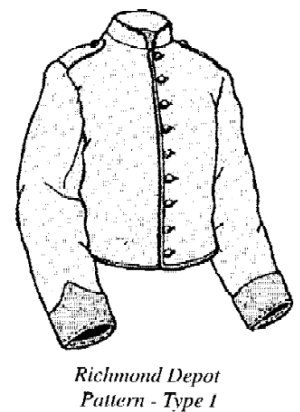

Type II jackets appeared in 1863 and were issued through that year until early 1864. This jacket had epaulettes and/or belt loops, but does not appear to have been trimmed. Again a variety of materials and colours appear to be in existence, perhaps with a tendency towards more jeancloth and satinette, than wool.
Type III were produced from the middle of 1863 through to the war's end. These have no trim, no belt loops and no epaulettes. A Wytheville depot shell, of similar style to the type III was made from heavy dark grey wool, with nine brass button front, white cotton lining and one inside breast pocket, with a short stand up collar one-and-half inches high. The sleeves are cut full with a narrow cuff and a six piece body. The type III appears to have been made in a variety of grey wool, Richmond Grey, the Wytheville Grey and Charcoal Grey. None of these have the true early war blue grey hue. The apparent lack of variation in colour of all the examples, bears testament to the stability of the imported English dyes that had come through from mid-war onwards. It is ironic really, that at the end of the war, the Confederacy was more likely to have appeared more uniform than it ever had in it's heyday. A Charlotte Depot Jacket had full, baggy sleves that were eased into the arm holes; a mid-high stand-up collar, six brass buttons, rounded front panels and two inside patch pockets.
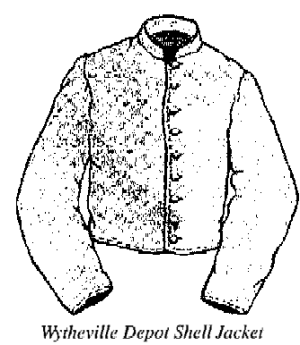

North Carolina maintained a private depot in Richmond where State troops were issued clothing from. As an illustration, the 4th North Carolina was issued on April 4th 1863, 2,000 jackets, 500 pairs of drawers, 635 shirts, 2,030 pairs of pants, 1,500 pairs of socks, 1,980 pairs of shoes and 100 caps, all in new condition. The regiment at this time numbered not more than 500 men. Considering the campaigning that the unit had in front of it that year, and the fact that most would have travelled light, it is a wonder what they would have done with all of these clothes. Longstreet's two divisions were said to have been issued with North Carolina uniforms of a dark grey blue kersey prior to their movement to Tennessee in September 1863. There is a myth, however, attached to this issue of 'blue' North Carolina jackets to Longstreet's troops. The belief is that these jackets were, firstly from North Carolina stocks, secondly, are made from 'English' cloth. It is true that some of Longstreet's Corps did wear clothing that appeared very dark blue. At Chickamauga in September 1863, soldiers from both armies made comment of this fact. Some western Confederates at first took them to be Federals, both from the colour, and the uniformity. Even Grant made comment of it owing to a chance meeting with one of Longstreet's soldiers at Chattanooga creek. The Confederate was wearing a jacket "of little different shade from our own uniform."
However, in looking to explain this one must examine the facts. North Carolina buttons have been found by relic hunters all over northern Georgia. North Carolina did have stocks of 'English Army cloth', imports had begun in June 1863 when the States blockade runner Advance had brought it in. Examples of jackets made from similarly imported cloth appear a dark blue-grey, very different to the usual Confederate grey. Confederate authorities also imported the same material during the same period. There is, however, no case for saying that any North Carolina depot jackets were made of 'army cloth.' Jackets made of similar fabrics that have been placed with North Carolina troops have been either attributed to the Peter Tait contract or Richmond depot. Surviving North Carolina depot jackets appear to have been made from jeancloth or satinette of grey and brown hues. It would seem that of the 100,000 uniforms on hand at the end of the war, much of these may have been the imported cloth. Longstreet did have an issue from the 10,000 North Carolina state uniforms 'loaned' to both himself and Johnson in February 1864. As there were none of that State's troops in Longstreet's divisions, a proportion must have gone to Johnson.
So where did these dark blue jackets come from, if not the North Carolina depot. It seems that after Gettysburg, Longstreet's Corps received replacement clothing and shoes at the camps near Culpeper. This was commented on by several writers at the time. As the troops moved south to join Bragg, Hoods and McLaws divisions passed through the Virginia depots, where they received "a dark blue close fitting jacket and light blue pants." Clearly then, the depots in the Virginia theatre were working towards greater uniformity and these jackets were no doubt early type III, grey-blue batch that had been over dyed.
Out of interest. in April 1864, Longstreet's Georgian troops, returning from Tennessee, received a State issue 'Joe Brown close', that was a very course, dingy white material. Conjecture could have it that these may have been Atlanta depot jackets.
Conclusion then on an Army of Northern Virginia 1863 impression
It is fairly obvious, that one jacket that would not have seen service in July 1863 would have been the late war, dark blue-grey Type III. Nor would this be an authentic choice for any one depicting Longstreet's or for that matter, North Carolina troops. through to the middle of 1864.
Type II, and perhaps Type I jackets made from a variety of materials, jeancloth, satinette, linsey-woolsey and even some wool. All would have been an overall grey in colour, but some may have tended towards a cadet grey or a brownish hue. Very few early war jackets would have survived this long, no militia uniforms from 1861, as an example, I give you the statistics below, that highlights the sheer amount of material the army consumed, which negates the survival of many early uniforms. In the last six months of 1864, General Lee's army received 104,199 jackets, 140,578 pairs of pants, 167,862 pairs of shoes, 74,851 blankets, 27,011 hats and caps, 21,063 flannel shirts, 157,727 cotton shirts. 170,139 pairs of drawers, 146,136 pairs of socks, 4,861 overcoats. Lee's army at this point did not exceed 67,000 men of which 400 of these were officers who generally acquired their own uniforms.
Overall general observations on both armies.
Colours varied from batch to batch, as in reality the Union material also did. One of the major differences and problems for the South was the chemicals for use in dyeing material. On occasions, material was used without dyeing. This only appears to be in the west. One brigade was issued with off-white jackets made from undyed, untreated wool. so much so that the men wearing them could not stand the smell and their more fortunate comrades, who did not have to wear them, made noises like sheep every time they passed.
Colours then from off-white to dark blue-grey. The main source was the depot system though and for the most part the styles reflect the geographical location of the soldiers and perhaps the distance from a source of supply.
The main fact that 'shines' through from any of the research that has been the fact that both armies would have looked very different. In the Army of Tennessee as well as Columbus Depot 1's and 2's, North Carolina Depot, the Atlanta would have been seen in large numbers. In the Army of Northern Virginia Type III jackets in dark grey wool worn with sky blue wool pants, would have been seen along with North Carolina in grey/brown jeancloth, Type II's in a mix of jeancloth and perhaps some wool. In three months, and the look would not have been the same. Still easy to be a Confederate!
Other sources of supply were open to Confederate troops. Sadly to say, theft from each other was high on the list. Also, soldiers would frequently request more uniform parts, some of these were sent home for domestic use and others sold off to less fortunate soldiers. All uniforms, especially shoes wore out very quickly under campaign conditions and two months would have been an average life expectancy. This does not mean that Confederate authorities would not have attempted to replace items, it purely means that at times a more readily available source would be closer to hand. These would be on the one hand, the Federal armies and secondly, and less so, civilian supplies. The Federal army played a very important part in clothing the Confederate army during the Virginia and Maryland campaigns of 1862. Federal dead, as well as captured items filled immediate voids in the system, many Confederate histories mention the role played by this source of supply. In the west, Forrest in late 1864 captured 27,900 blankets. 45,853 hats, 7,000 pairs of shoes and 61,860 cotton shirts in one raid alone.
Headgear
This showed considerable variation over time. Evidence does suggest that the head gear of the average Confederate enlisted man was a changing item, that seems to have depended more on availability than style or particular affections. There are cases, the Maryland Line in particular, that adopted a style and stuck to it, but these cases are rare.
Hats and caps were issued through the depot system. many of them being civilian hats bought by the Government. Many were procured by fair means, directly purchasing them, or foul, stealing from sutlers, each other or long arming, the method of exchanging hats with an unsuspecting civilian. Then there was the Texan method, that involved placing musket caps on train tracks and knocking off hats as people put their heads out to see what the noise was. Photographic evidence of Confederate regiments in the field, or that of prisoners of war, as well as the shear number of surviving examples suggests that on average the vast majority of both Confederate armies favoured a felt, or soft hat. These hats did not tend to be of the shapeless variety, nor did they appear to have feathers, bones or brass work attached, but they reflected the period in so much as they were stylish as the owner could make them. Hats that went soft and shapeless tended to be exchanged one way or another and were deemed to have been worn out.
Footwear
Shoes, or the lack of them, has always been cited as being one of the South's major problems. Much of what was issued was of such inferior quality that they wore out quickly under campaign conditions and many histories and personal recollections reflect on this. Yet, it would also appear that many of the troops went barefoot for their own reasons. One of the reasons being that "the heavy English shoes were so stiff, that skin came off the feet along with the socks." The most common reason does, however, appear to be that it was a good way of avoiding extra duties. So many bare foot men were seen around the camps at Fredricksburg in the winter of 1862-1863, that General Lee issued an order that guard duty would be mandatory for soldiers, shod or not. William Andrews of the 1st Georgia commented "that almost immediately, not a barefoot man was to be seen." One point that is of note. A few years ago in Texas, a mass Confederate grave was discovered and exhumed. It contained 40 fully clothed Confederates, all still wearing issue brogans. (Obviously no shortage of boots in Texas). Out of those 40, 20 had been repaired in a similar manner to those repaired today. Out of all the boots, repair or not, half had been made using a nailing process and the rest wooden pegs.
Footwear then, or lack of it, suggests that any uniformity would have been totally non-existent and that the reenactors myth of having pegged soles is not always true.
Conclusion
I hope that this attempt has been useful in trying to attempt to put into some perspective what we should be trying to achieve. There is a need for an overall impression, but it must be remembered that while achieving this, we may be striving towards a goal that did not exist in real life. It is difficult to accept that we are doing things wrong, we are after all trying to portray different units in different theatres, at different times. I hope that by going some way towards understanding the variations that we can accept all the dilferences between all the units. Naturally, I expect many to disagree with my comments, we do, however. need to accept, that all units will not be the same and will not wear the same.
Sources
Survey of Confederate Central Government Quartermaster Issue Jackets - Part 1 & Part 2.- Les Jenson
Military Collector and Historian - Volume XLI No 3 & No 4.
Camp Chase Gazette September 1989.
Various issues of the Confederate Veteran - Sons of Confederate Veterans magazine
History of the 1st Georgia Volunteers - Footprints of a Regiment
Echo's of Glory - Time-Life Books.
Soldiering in the Army of Tennessee - Larry J Daniel.
Resources of the Confederacy - Southern Historical Society Papers.
Shades of Gray - Military Illustrated Issue 88.
Chickamauga Bloody Battle of the West.
This Terrible Sound.
Grand Illusions Catalogue.
Quartermasters Store Catalogue.
Bethel to Sharpsburg.
Personal Memoirs of US Grant - Dover Publications.
Official Records of the Civil War.
Jackets of the Army of Tennessee - Lee White - Camp Chase Gazette.
The Material Evidence Confederate Columbus Depot Jackets Parts 1 & 2 - Geoff Walden - Camp Chase Gazette.
Above article originally published in the December/January 1998 and the February/March 1999 Bugle Call, the journal of the Southern Skirmish Association. Reprinted with permission.
